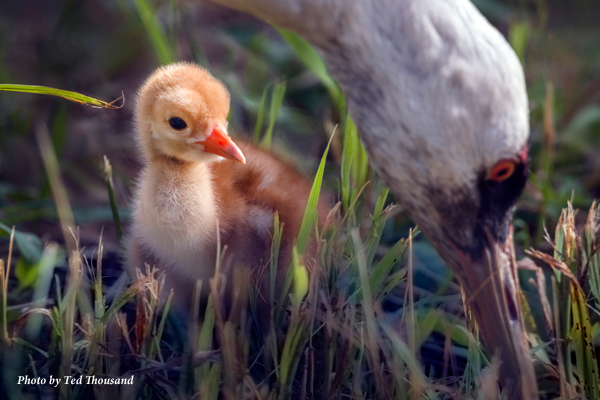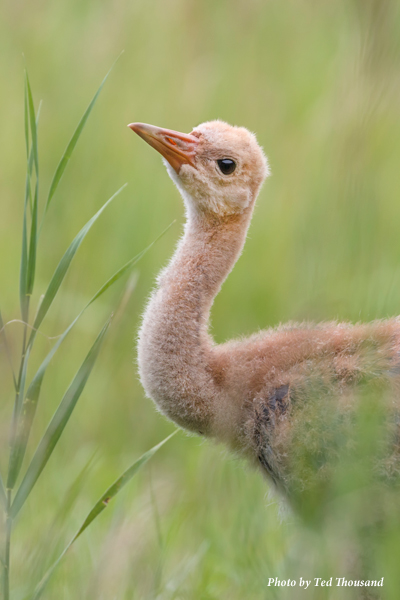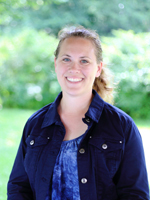
This story begins several years ago with a Hooded Crane egg, produced at the International Crane Foundation, and its whirlwind journey across the country to the Woodland Park Zoo in Seattle. The egg was originally intended to hatch at the Denver Zoo, and in fact, a Denver Zoo aviculturist was accompanying the egg when the flight plan was re-routed after a late-breaking update that the Woodland Park Zoo had a pair of Hooded Cranes incubating. That well-travelled egg produced in Baraboo, Wisconsin ended up in the care of a different pair of Hooded Cranes across the country in Seattle!
The new parents, Aliena and Quercus, had been unable to produce fertile eggs of their own, so the Association of Zoos & Aquarium’s Species Survival Program (SSP) initiated the egg transfer to strengthen the captive population of Hooded Cranes. SSPs are conservation programs where accredited zoos holding a particular species participate in breeding and transfer recommendations aimed at creating a sustainable captive population that is healthy and genetically diverse. A few days after that flight, a bright, downy chick appeared to the world.
You might think that was the end of the story…
Last year, a similar cross-country exchange occurred, but instead of an egg, this time it was Aliena and Quercus traveling from Seattle to their new home at the International Crane Foundation. The pair had proven themselves as excellent parents with their foster chick, and the Hooded Crane SSP hoped that the transfer would finally enable the pair (with the assistance of the International Crane Foundation’s artificial insemination program) to successfully produce their own offspring – especially because they are two of the most genetically valuable Hooded Cranes in captivity.
Moving to a new home is stressful and it takes time to settle in. Our staff patiently watched the pair acclimate to their new surroundings with little expectation that they would be comfortable enough to lay eggs only months after undergoing such a big event. But the pair adjusted to the change effortlessly, and during their first breeding season, Aliena laid four eggs. Unfortunately, they were all infertile. The infertility was expected, but knowing Aliena was relaxed enough to produce eggs was good news.
This year, based on SSP recommendations, two pairs of our Hooded Cranes, including Aliena and Quercus, were a focus of our 2017 breeding plan. The pairs produced five fertile eggs (Aliena and Quercus produced three of them). We kept two of the eggs, one from each pairing. The remaining three eggs were transferred to the Denver Zoo, but unfortunately, all three of those eggs died during the hatching process, underscoring the difficulty of breeding this species in captivity.
On June 13, 2017, this story came full circle as a plump, fuzzy chick hatched. Aliena and Quercus were finally caring for their very own chick, Opal! To the joy of our visitors, Opal is being raised on exhibit by her doting parents, where they are excellent ambassadors for their species. And as if that wasn’t enough good news for one breeding season, the second fertile egg also survived. The chick, Geode, is being reared off-exhibit in Crane City.

The significance of this story is not just the rare chicks, but more so the care and collaboration of many zoos working together to maintain a healthy captive Hooded Crane population. Had it not been for the leadership of John Azua, Hooded Crane SSP coordinator at the Denver Zoo, managing the breeding and transfer recommendations, Woodland Park Zoo for their willingness to transfer Aliena and Quercus, and the International Crane Foundation having specialized captive breeding expertise, the valuable genetic material that is Opal might have been lost.
With this hatch, we celebrate the future of a new individual to carry on the unique lineage of its parents and fulfill the purpose of the SSP. When we see Opal, we don’t just see a crane chick, we see the hard work, dedication, and years of collaboration between aviculturists across the country to produce a gem like Opal.
 Story submitted by Cyndie Gitter, Assistant Curator of Birds for the International Crane Foundation. Click here to learn more about our Global Headquarters Programs.
Story submitted by Cyndie Gitter, Assistant Curator of Birds for the International Crane Foundation. Click here to learn more about our Global Headquarters Programs.
